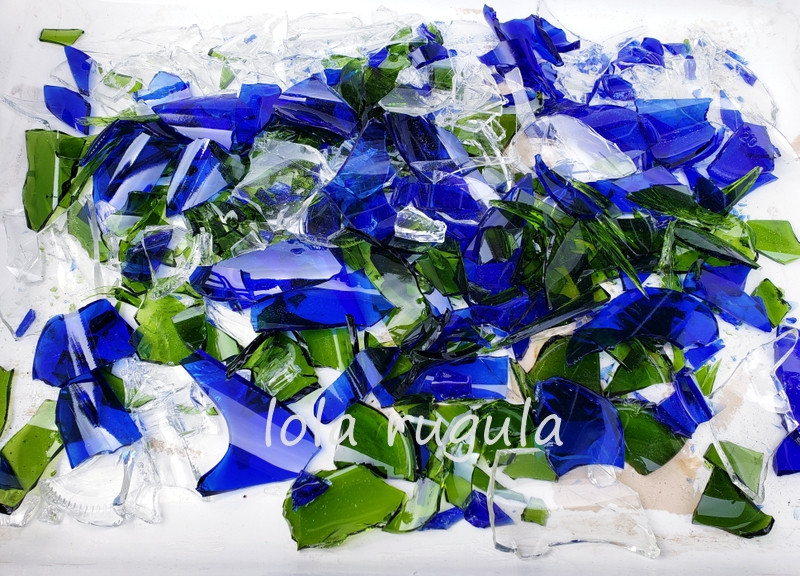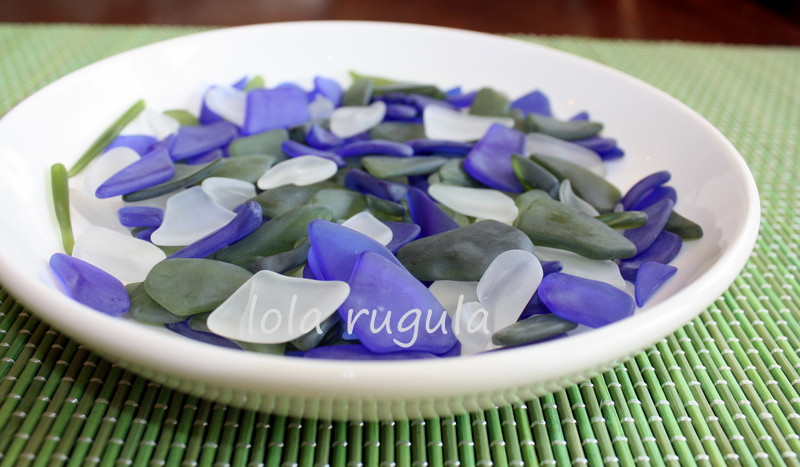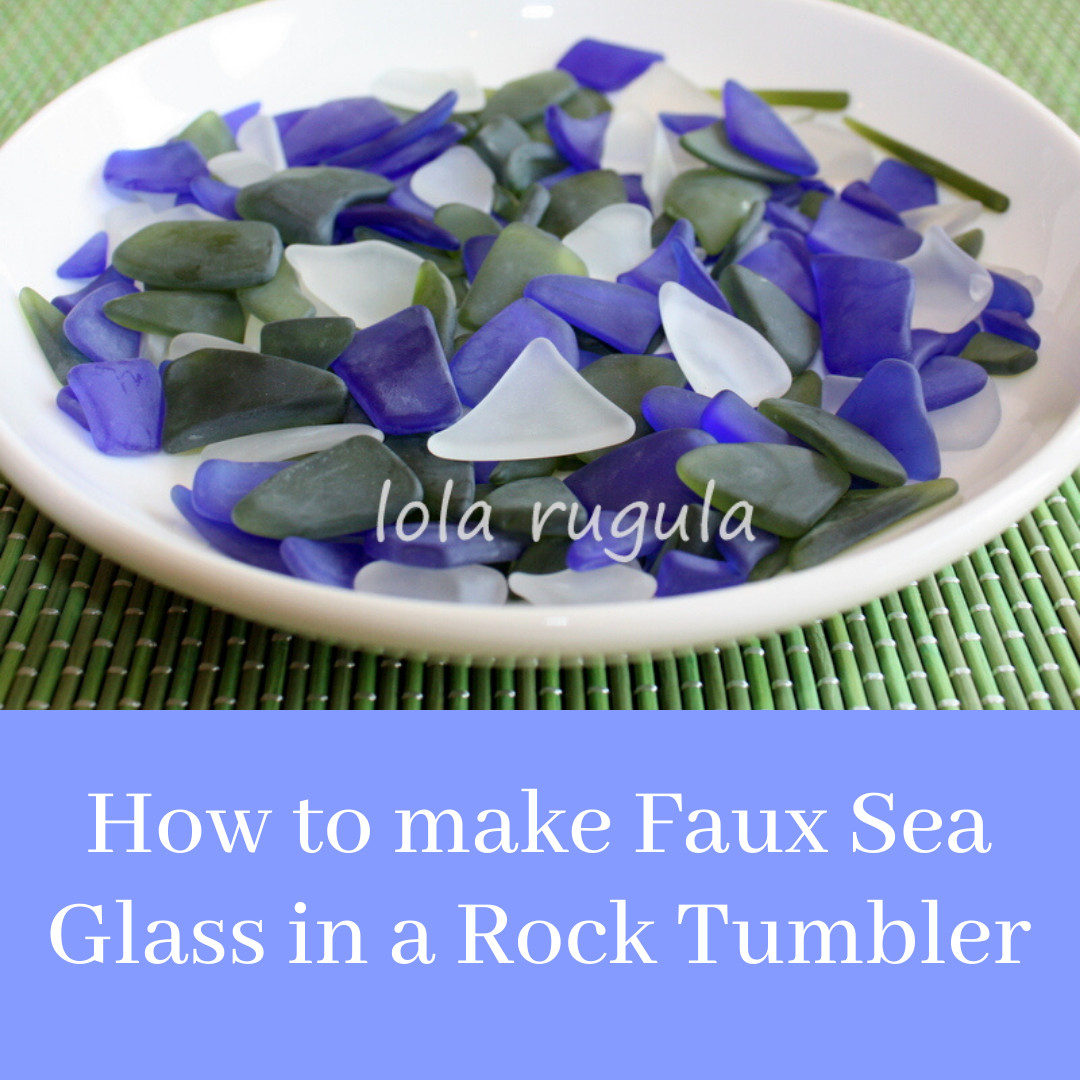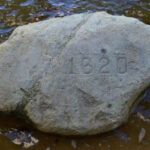Can You Put Sea Glass In A Rock Tumbler? Absolutely, you can put sea glass in a rock tumbler to refine its edges and enhance its frosted appearance. At rockscapes.net, we’re dedicated to helping you discover the beauty and potential of incorporating rocks and sea glass into your landscape and creative projects, offering expert advice and inspiration for all your rock-related endeavors. Sea glass landscaping adds a unique, artistic touch to any outdoor space.
1. What Exactly Is Sea Glass, and Can a Rock Tumbler Help?
Sea glass is formed from broken pieces of glass that have been tumbled and smoothed by the waves and sand over many years. A rock tumbler can mimic this natural process, but is it really effective?
1.1 The Origins of Sea Glass
Sea glass typically originates from discarded bottles, jars, and even shipwrecks. The constant action of the ocean transforms these shards into smooth, frosted gems.
1.2 Can You Replicate Nature’s Process?
Yes, you can replicate the natural process with a rock tumbler, although it requires careful attention to detail. Using a rock tumbler allows you to achieve a similar frosted and smooth finish in a fraction of the time it would take nature.
1.3 What Are the Benefits of Using a Rock Tumbler for Sea Glass?
Using a rock tumbler offers several benefits:
- Control: You have complete control over the process, ensuring the desired level of smoothness and frosting.
- Speed: The tumbling process is much faster than waiting for natural wave action.
- Customization: You can create sea glass from various types of glass, including wine bottles, and customize the colors and sizes.
- Consistency: Achieve a consistent look across multiple pieces, ideal for crafting or decorative projects.
2. What Kind of Glass Works Best in a Rock Tumbler?
Not all glass is created equal. Some types of glass are more suitable for tumbling than others. Which should you choose?
2.1 Soft Glass Versus Hard Glass
Soft glass, like that found in wine bottles, is generally easier to tumble than harder glass types. Hard glass may require more time and coarser grits to achieve the desired effect.
2.2 The Role of Thickness
Thicker pieces of glass can withstand the tumbling process better than thin shards, which may break down too quickly. It’s best to start with a variety of thicknesses to see what works best in your tumbler.
2.3 Can You Use Wine Bottles?
Yes, wine bottles can be an excellent source of glass for tumbling. The different colors and thicknesses of wine bottles offer a variety of options for creating unique sea glass pieces.
3. What Equipment Do You Need to Tumble Sea Glass?
Before you start, it’s important to gather the right equipment to ensure a successful tumbling process. What should you have on hand?
3.1 Selecting the Right Rock Tumbler
A dual 3 lb rock tumbler is a great choice for starting this project. You can also use a rotary tumbler with multiple speeds, as it offers more control over the tumbling process.
3.2 What Kind of Tumbling Grit Should You Use?
Tumbling grit comes in various grades, from coarse to fine. A four-step process is generally recommended:
- Coarse Grit: To grind down sharp edges and begin the smoothing process.
- Medium Grit: To further smooth the glass.
- Fine Grit: To prepare the surface for polishing.
- Polish: To create a frosted, sea glass finish.
3.3 The Importance of Ceramic Media
Ceramic pellets or shapes are essential for cushioning the glass and preventing it from breaking during the tumbling process. They also help distribute the grit evenly.
3.4 Safety Gear
Safety is paramount when working with glass. Always wear safety goggles, gloves, and a dust mask to protect yourself from sharp edges and glass particles.
4. Step-by-Step Guide: How to Tumble Sea Glass
Let’s walk through the process of tumbling sea glass, from breaking the glass to the final polish.
4.1 Breaking the Glass Safely
- Preparation: Place the wine bottle or other glass inside a paper bag and cover it with a towel.
- Protection: Wear safety goggles and a dust mask.
- Breaking: Use a tack hammer to break the glass into smaller pieces. Aim for pieces that are approximately the size you want your finished sea glass to be.
Here’s a shot of original glass breakage.
 Original glass breakage for tumbling
Original glass breakage for tumbling
4.2 The First Tumble: Coarse Grit
- Loading: Fill the tumbler barrel about 2/3 full with glass pieces.
- Cushioning: Add ceramic pellets to fill the remaining space, cushioning the glass.
- Grit: Add 3 tablespoons of coarse grit.
- Water: Fill the barrel with water until the water level is just below the top of the glass and pellets.
- Tumbling: Seal the barrel and tumble for 7-10 days, checking periodically.
4.3 The Second Tumble: Medium Grit
- Cleaning: Remove the glass and ceramic pellets from the tumbler. Rinse everything thoroughly to remove any remaining coarse grit.
- Reloading: Place the glass and ceramic pellets back into the tumbler.
- Medium Grit: Add 3 tablespoons of medium grit.
- Water: Fill the barrel with water as before.
- Tumbling: Tumble for another 7 days, checking periodically.
4.4 The Third Tumble: Fine Grit
- Cleaning: Repeat the cleaning process.
- Reloading: Place the glass and ceramic pellets back into the tumbler.
- Fine Grit: Add 3 tablespoons of fine grit.
- Water: Fill the barrel with water.
- Tumbling: Tumble for another 7 days, checking periodically.
4.5 The Final Tumble: Polishing
- Cleaning: Repeat the cleaning process meticulously to ensure no grit remains.
- Reloading: Place the glass and ceramic pellets back into the tumbler.
- Polish: Add 3 tablespoons of polishing compound.
- Water: Fill the barrel with water.
- Tumbling: Tumble for a final 7 days, checking periodically for the desired frostiness.
4.6 Achieving the Frosted Look
The final polish is crucial for achieving the frosted look of natural sea glass. Experiment with different polishing compounds to find the one that gives you the best results.
5. How Long Does It Take to Tumble Sea Glass?
Patience is key. Tumbling sea glass is not a quick process, but the results are worth the wait.
5.1 Factors Affecting Tumbling Time
- Type of Glass: Softer glass will tumble faster than harder glass.
- Size of Pieces: Smaller pieces will smooth more quickly than larger ones.
- Tumbler Speed: Faster tumblers will reduce the overall time, but can also increase the risk of breakage.
- Grit Quality: Higher quality grit will work more efficiently.
5.2 Average Tumbling Timeline
On average, the entire process can take between 4 to 6 weeks. Here’s a general timeline:
- Coarse Grit: 7-10 days
- Medium Grit: 7 days
- Fine Grit: 7 days
- Polish: 7 days
5.3 Regular Checks and Adjustments
Regularly check the glass to monitor its progress. If the edges are still too sharp, you may need to extend the coarse grit stage. If the frosting is not pronounced enough, extend the polishing stage.
6. What Are the Common Pitfalls and How Can You Avoid Them?
Even with careful preparation, things can go wrong. Here are some common issues and how to avoid them.
6.1 Glass Breaking Too Much
If the glass is breaking down too much, try these solutions:
- Reduce Tumbler Speed: Use a lower speed setting on your tumbler.
- Add More Ceramic Media: Increase the amount of ceramic pellets to provide more cushioning.
- Check for Overfilling: Ensure the tumbler is not overfilled, as this can cause excessive pressure.
6.2 Not Enough Frosting
If the glass is not frosting properly, consider these adjustments:
- Use a Different Polishing Compound: Experiment with different brands and types of polishing compounds.
- Extend Polishing Time: Allow the glass to tumble for a longer period in the polishing stage.
- Ensure Proper Cleaning: Make sure all traces of grit are removed before the polishing stage.
6.3 Uneven Smoothing
Uneven smoothing can occur if the glass pieces are not tumbling freely. Try these tips:
- Adjust the Load: Make sure the tumbler is not too full or too empty.
- Check Ceramic Media Distribution: Ensure the ceramic pellets are evenly distributed throughout the barrel.
- Inspect for Obstructions: Check for any large pieces that may be preventing other pieces from tumbling properly.
7. Creative Uses for Your Tumbled Sea Glass
Once you have a collection of beautifully tumbled sea glass, the possibilities are endless.
7.1 Jewelry Making
Sea glass makes stunning pendants, earrings, and bracelets. Its frosted appearance and unique shapes add a touch of coastal charm to any piece.
7.2 Home Decor
Use sea glass to create mosaics, picture frames, or decorative accents for vases and bowls. Its calming colors and smooth texture bring a sense of tranquility to any space.
7.3 Landscaping
Incorporate sea glass into your garden or outdoor spaces as decorative mulch, edging, or accents in rock gardens.
7.4 Craft Projects
From suncatchers to wind chimes, sea glass can be used in a wide variety of craft projects. Let your imagination run wild.
This is a mix of skinny glass and thicker neck and bottom-of-the-bottle glass from 3 different average wine bottles.
 Tumbled sea glass pieces for jewelry
Tumbled sea glass pieces for jewelry
8. The Science Behind the Frosting: Why Does It Happen?
Understanding the science behind the frosting process can help you achieve better results.
8.1 Abrasion and Erosion
The frosting on sea glass is a result of abrasion and erosion caused by the tumbling action of grit and water. Over time, the sharp edges are worn down, and the surface becomes textured.
8.2 The Role of Silicates
Glass is primarily composed of silicates. The tumbling process breaks down the surface silicates, creating microscopic fractures that scatter light and give the glass its frosted appearance.
8.3 Chemical Reactions
Some polishing compounds contain chemicals that react with the surface of the glass, further enhancing the frosting effect.
9. What Are the Environmental Considerations?
Being mindful of the environmental impact is important when creating sea glass.
9.1 Sourcing Glass Responsibly
Whenever possible, source glass from recycled materials or local sources. This reduces the environmental impact associated with manufacturing and transportation.
9.2 Disposing of Tumbling Waste
Dispose of used tumbling grit and water properly. Do not pour it down the drain, as it can clog pipes and contaminate water systems. Instead, allow the sediment to settle, then dispose of the solid waste in the trash and the water in a designated area.
9.3 Minimizing Energy Use
Use your rock tumbler efficiently to minimize energy consumption. Run it for longer periods at lower speeds, and consider using a timer to avoid running it unnecessarily.
10. Expert Tips for Perfect Sea Glass
Here are some additional tips from experts in the field to help you create perfect sea glass every time.
10.1 Start with Clean Glass
Always start with clean glass to prevent contamination of the tumbling grit.
10.2 Use a Dedicated Tumbler
If possible, use a separate tumbler for glass than you do for rocks. This will prevent cross-contamination of grit and ensure the best results.
10.3 Monitor Water Levels
Check the water levels regularly and add water as needed to keep the glass properly submerged.
10.4 Keep a Log
Keep a log of your tumbling process, including the types of grit used, tumbling times, and any adjustments made. This will help you replicate your results in the future.
10.5 Experiment
Don’t be afraid to experiment with different types of glass, grit, and polishing compounds. The best way to learn is through trial and error.
I’m very happy with the final results and hope that my struggles but the final success in recreating sea glass here are helpful to you.
 Finished sea glass ready for crafting
Finished sea glass ready for crafting
11. Sea Glass vs. Beach Glass: What’s the Difference?
While often used interchangeably, there’s a subtle distinction between sea glass and beach glass. Sea glass is typically found in saltwater environments, while beach glass can be found in freshwater environments. The composition and appearance are generally the same.
11.1 Saltwater vs. Freshwater
The primary difference is the environment in which the glass is tumbled. Saltwater can have a slightly different effect on the glass compared to freshwater, but the end result is similar.
11.2 Identifying Genuine Sea Glass
Genuine sea glass will have a frosted appearance, smooth edges, and may have slight imperfections. These imperfections are a sign of the natural tumbling process.
11.3 The Appeal of Both
Whether it’s called sea glass or beach glass, the appeal lies in its unique beauty and the story it tells of its journey through the water.
12. Can I Tumble Other Materials with Sea Glass?
While it’s best to tumble glass on its own, there are some materials that can be tumbled with sea glass to enhance the process or create unique effects.
12.1 Tumble Sea Glass with Shells?
Yes, but it’s not generally recommended to tumble sea glass with shells, as the shells can be more fragile and may break down during the tumbling process.
12.2 Tumble Sea Glass with Rocks?
No, it’s also not a good idea to tumble sea glass with rocks, as the rocks can be too abrasive and may damage the glass.
12.3 Tumble Sea Glass with Ceramic Pellets
Ceramic pellets are the best option for tumbling with sea glass, as they provide cushioning and help distribute the grit evenly without damaging the glass.
13. Does the Type of Rock Tumbler Matter?
The type of rock tumbler you use can have a significant impact on the results.
13.1 Rotary Tumblers
Rotary tumblers are the most common type and are suitable for tumbling sea glass. They work by slowly rotating the barrel, allowing the grit and water to grind down the glass.
13.2 Vibratory Tumblers
Vibratory tumblers use vibration to tumble the glass. They are faster than rotary tumblers but can be more aggressive, increasing the risk of breakage.
13.3 Choosing the Right Tumbler
For best results, choose a rotary tumbler with adjustable speed settings. This will allow you to control the tumbling process and minimize the risk of damage.
14. How Does Temperature Affect the Tumbling Process?
Temperature can play a role in the tumbling process, although it’s not as significant as other factors like grit and tumbling time.
14.1 Warm vs. Cold Water
Warm water can help to soften the glass slightly, making it easier to grind down. However, it’s not necessary to use warm water, as cold water will work just as well.
14.2 Ambient Temperature
The ambient temperature of the room can also affect the tumbling process. If the room is too cold, the tumbling compound may not work as effectively.
14.3 Maintaining a Consistent Temperature
For best results, maintain a consistent temperature in the room where you are tumbling the glass.
15. How to Store Your Tumbled Sea Glass
Proper storage is essential for preserving the beauty of your tumbled sea glass.
15.1 Cleaning Before Storing
Before storing your sea glass, make sure it is clean and dry. This will prevent the growth of mold or mildew.
15.2 Storing in a Dry Place
Store your sea glass in a dry place away from direct sunlight. This will prevent fading and discoloration.
15.3 Using Display Cases
Consider using display cases or shadow boxes to showcase your sea glass collection. This will protect it from dust and damage while allowing you to enjoy its beauty.
16. What Are Some Alternatives to Rock Tumbling?
If you don’t have a rock tumbler, there are some alternative methods you can use to create sea glass.
16.1 Hand Sanding
Hand sanding is a labor-intensive but effective way to smooth the edges of glass. Use a series of progressively finer grits of sandpaper to achieve the desired effect.
16.2 Chemical Etching
Chemical etching involves using chemicals to dissolve the surface of the glass, creating a frosted appearance. This method should be used with caution, as the chemicals can be hazardous.
16.3 Natural Tumbling
If you live near a beach, you can try tumbling the glass naturally by placing it in a mesh bag and securing it to a rock or pier. The waves will do the rest.
17. How to Tell if Your Sea Glass Is Authentic or Fake?
With the increasing popularity of sea glass, it’s important to be able to distinguish between authentic and fake sea glass.
17.1 Look for Imperfections
Authentic sea glass will have slight imperfections, such as bubbles or scratches.
17.2 Check the Surface
The surface of authentic sea glass will be frosted and smooth to the touch.
17.3 Examine the Edges
The edges of authentic sea glass will be rounded and smooth.
17.4 Consider the Source
Purchase sea glass from reputable sources to ensure its authenticity.
18. Is It Legal to Collect Sea Glass from Beaches?
The legality of collecting sea glass from beaches varies depending on the location.
18.1 Local Regulations
Check local regulations before collecting sea glass from beaches. Some beaches may prohibit the removal of any materials, including sea glass.
18.2 Private vs. Public Beaches
Private beaches may have different regulations than public beaches. Obtain permission from the property owner before collecting sea glass from a private beach.
18.3 Respecting the Environment
Whether it’s legal or not, always collect sea glass responsibly and respect the environment.
19. The History of Sea Glass Collecting
Sea glass collecting has a rich history, dating back to the early days of glass production.
19.1 Early Glass Production
In the early days of glass production, waste glass was often dumped into the ocean.
19.2 The Rise of Sea Glass Collecting
As people began to appreciate the beauty of sea glass, sea glass collecting became a popular hobby.
19.3 Modern Sea Glass Collecting
Today, sea glass collecting is enjoyed by people all over the world.
20. The Future of Sea Glass and Rock Tumbling
The future of sea glass and rock tumbling is bright, with new innovations and techniques constantly emerging.
20.1 Sustainable Practices
As environmental awareness grows, sustainable practices will become increasingly important in sea glass and rock tumbling.
20.2 New Technologies
New technologies, such as 3D printing, may revolutionize the way sea glass is created and used.
20.3 The Enduring Appeal of Sea Glass
Despite the changes, the enduring appeal of sea glass will continue to captivate people for generations to come.
Creating sea glass in a rock tumbler is a rewarding process that allows you to transform ordinary glass into beautiful, frosted gems. With the right equipment, techniques, and a little patience, you can create stunning sea glass pieces for jewelry, home decor, and more.
Remember, safety is paramount when working with glass. Always wear safety goggles, gloves, and a dust mask to protect yourself from sharp edges and glass particles.
At rockscapes.net, we are committed to providing you with the information and resources you need to create beautiful and sustainable landscapes and craft projects. Visit our website at rockscapes.net or stop by our location at 1151 S Forest Ave, Tempe, AZ 85281, United States, or call us at +1 (480) 965-9011 for expert advice and inspiration.
FAQ: Tumbling Sea Glass
1. Can you put sea glass in a rock tumbler?
Yes, you can put sea glass in a rock tumbler to smooth the edges and enhance the frosted appearance, giving it a more refined and appealing look for various craft and decorative purposes.
2. What type of glass is best for tumbling?
Soft glass, like that found in wine bottles, is generally easier to tumble compared to harder glass types, making the tumbling process more efficient and yielding better results.
3. How long does it take to tumble sea glass?
On average, the entire tumbling process for sea glass takes between 4 to 6 weeks, depending on the glass type, tumbler speed, and desired level of smoothness.
4. What grit should I use for tumbling sea glass?
A four-step process is typically recommended, starting with coarse grit to grind down sharp edges, followed by medium and fine grits to smooth the glass, and finishing with a polish to create the frosted sea glass look.
5. Do I need ceramic media when tumbling sea glass?
Yes, ceramic pellets or shapes are essential as they cushion the glass, prevent breakage during tumbling, and help distribute the grit evenly for a consistent finish.
6. What safety precautions should I take when tumbling glass?
Always wear safety goggles, gloves, and a dust mask to protect yourself from sharp edges and glass particles when handling and tumbling glass.
7. What if the glass breaks too much during tumbling?
If the glass is breaking down too much, try reducing the tumbler speed, adding more ceramic media for cushioning, and ensuring the tumbler is not overfilled.
8. How do I get the best frosted look on sea glass?
Achieve the best frosted look by using a quality polishing compound, extending the polishing time, and ensuring all traces of grit are removed before the polishing stage.
9. Can I tumble sea glass with other materials?
It’s generally best to tumble sea glass on its own or with ceramic pellets, as other materials like rocks or shells can damage the glass or break down during the process.
10. How do I store tumbled sea glass?
Store your tumbled sea glass in a dry place away from direct sunlight, and consider using display cases to protect it from dust and damage while showcasing its beauty.
Ready to transform ordinary glass into extraordinary sea glass? Visit rockscapes.net for all the supplies, tips, and inspiration you need to get started on your sea glass tumbling adventure today!
